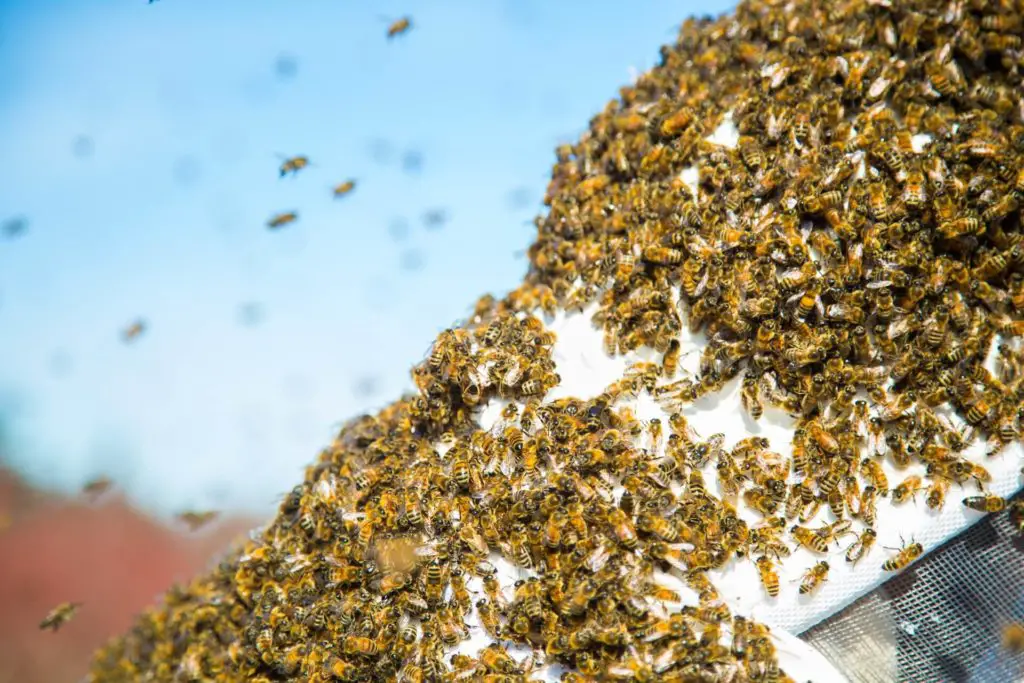Last updated on September 21st, 2023 at 12:08 pm
Yes, if bees are unable to leave the hive to collect water they are at risk of overheating. Signs of overheating include bearding (huddling in large numbers outside the hive), increase activity to collect and deposit water in the hive or in extreme cases melting honey and wax.
Keeping bees in warmer climates comes with its own set of individual challenges. One of these is how to keep your colonies cool during very hot weather.
With that in mind let’s look at how bees are affected by heat and some of the ways you can ensure your hives aren’t affected during particularly hot days.
What’s the ideal temperature for bees
Honeybees will strive to keep the hive’s internal temperature around 35°C. Throughout winter and the colder months, bees achieve this by massing together to maintain body heat often referred to as ‘huddling’, sealing any cracks in the hive with propolis and buzzing their wings to generate friction and in turn heat.
When it comes to summer and overheating bees have a fascinating set of strategies to avoid overheating. During particularly hot days foraging bees will return to the hive with water alongside their normal cargo of nectar and pollen. This water is then left inside the hive to evaporate and cool the air inside the hive.
Interestingly bees within the hive can beat their wings to increase the speed of evaporation and circulate air throughout the hive, both providing a cooling effect for the hive and its inhabitants.
How do you know if bees are overheating?
If the temperature inside your hives increases to unacceptable levels it can have some catastrophic consequences for the colony.
Young broods are not as well equipped as adult bees when it comes to maintaining their own body temperature and are often the first to perspire in cases of overheating. While this may not have an immediate effect, the lack of maturing young bees in the coming months will significantly hamper the colony. and its ability to forage.
Some of the key signs your hive is suffering from overheating are:
Significant increase in activity – This is a likely sign your bees are taking trips to collect water and cool the hive via evaporation.
Wax or honey melting – Very hot temperatures can lead to the honey and wax inside your hives melting. While this will only happen in extreme circumstances it’s a sure-fire signal your hive is far too hot.
Large numbers of bees located on the exterior of the hive – This is often referred to as ‘bearding’ and displays as large groups of bees clustered outside the hive to escape the rising internal temperatures.
How to protect bees from overheating and hot weather
Now we’ve got a good understanding of how bees take action to mediate overheating let’s look at some ways humans can intervene to avoid bees suffering during hot days.
Provide a water source
Bees need a suitable water source to allow them to cool the hive via evaporation. They collect water inside their honey gut before returning to the hive. Bees are notoriously picky with their water sources so establishing this before the hotter months arrive is preferable.
Offer shade
This very simple but effective technique can quickly and effectively reduce the temperature inside your bee’s hive. This can take the form of a simple umbrella or parasol placed over your hive during the hottest part of the day.
If you live in a very hot climate consider situating your hives under some natural shade from trees.
Add insulation
Beekeepers often add insulation to their hives during colder months to help bees maintain temperature. Exactly the same is true of heat and investing in some insulation will help keep your hive cool.
Avoid metal roofs
Metal hive roofs look fantastic and last far longer than wooden alternatives but conduct heat and can become very hot in prolonged sunlight. If you live in an area with very hot summers avoid using a metal roof because this will add to the heat within the hive.
Only use light colours
Dark colours absorb heat from the sun so make sure your hives are either plain wood or painted in a light colour.
Removing frames
Some beekeepers will opt to remove frames during the summer to increase airflow throughout the hive.




